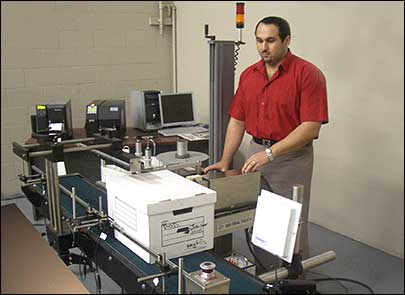Ship2Save, a Montreal-based RFID services company, has begun operating what it says is the first RFID-ready warehouse in Canada. Opened last week, the 22,000-square-foot facility includes a 10,000-square-foot “compliance center,” where pallets, cases and large individual items—currently, heavy equipment parts—are tagged to meet the RFID needs of the goods’ intended recipients. The facility also sports a 12,000-square-foot storage area, where the tagged goods are held until they can be trucked to their ultimate destination.
Firm executives say they have already secured contracts with two companies and are in negotiations with several manufacturers and retail distributors as well. Ship2Save won’t specify the companies, but says it is providing so-called “slap-and-ship” RFID services in the small warehouse. Such a facility offers manufacturers and wholesalers a short cut to meeting the RFID requirements of their customers, such as the retailers Wal-Mart and Target. At slap-and-ship facilities like Ship2Save’s, RFID tags are printed, encoded and applied to goods in accordance with retailers’ mandates, then reshipped to retailer distribution warehouses or other destinations.
Ship2Save uses a variety of tags in its operation, including those from Avery Dennison, Symbol Technologies (formerly Matrics) and Alien Technology. Its choice of readers is equally eclectic, from Alien, AWID, SAMSys and others, according to Sam Falsafi, the firm’s director of business development.
If that variety sounds more like a showroom than a working facility, it may be because, until recently, that’s what it was. Falsafi says the showroom, where his firm demonstrated various kinds of RFID equipment, is still there today. However, in addition to looking at RFID-enabled conveyers used to test and verify the tags on a vendor’s individual products against retail mandates, visitors now also get a chance to see a working RFID-enabled warehouse.
In addition to using the new RFID-enabled warehouse to provide slap-and-ship services, Ship2Save believes it will serve to demonstrate the company’s expertise in RFID. Falsafi hopes that after potential customers visit its warehouse, they will hire the firm to design and deploy RFID systems at their premises. “It’s pretty difficult to bring people on board with only a PowerPoint presentation,” he explains.
Falsafi says the facility will also be useful as a test bed. Already, the firm has learned something about how to cope with goods with a high-metal content. For instance, one of the first customers using the new facility is a manufacturer of metal springs for heavy equipment. The springs, which can weigh thousands of pounds and measure up to 6 feet wide and 12 feet long, presented a special challenge for tagging because metal interferes with the radio signals emitted by the RFID tags and readers. To get 100 percent readings of the reusable RFID tags attached to the springs, Ship2Save engineers developed a cardboard and Bubble Wrap backing for the tags. This backing kept the sensitive electronic components farther away from the springs’ metal surface, according to Falsafi.
Currently, other tests are underway at the facility. Specifically, Falsafi says the firm is experimenting with active tags and location software.
Some industry observers believe, however, that in order for Ship2Save to effectively offer slap-and-ship services, it will need a larger warehouse. Carla Reed, an RFID analyst for ChainLink Research in Cambridge, Mass., says she thinks the facility’s relatively small size—most distribution centers average around 300,000 square feet, according to Reed—may prove a limiting factor to its usefulness.
“At any level of volume,” Reed says, “I don’t know how cost-effective a small operation like that would be [to shippers].” While using such a facility provides a shortcut to RFID compliance, Reed says it also adds another step to the supply chain, in addition to whatever steps are now needed, since there isn’t much room to use the facility as a true warehouse.
In operating the facility, the four-year-old company is currently working with a third-party logistics firm Falsafi would not identify. He does say, though, that Ship2Save strategists are hoping to build more of its RFID services business under the logistic firm’s own name.
If all goes well, Ship2Save plans to build a similar RFID-enabled facility on the U.S. side of the border. By mid-2006, Falsafi explains, his company plans to convert a slightly larger warehouse it owns on Lake Champlain, in New York, into an RFID-enabled facility. This, he adds, will make his company’s services more accessible to Northeastern U.S. clients.


